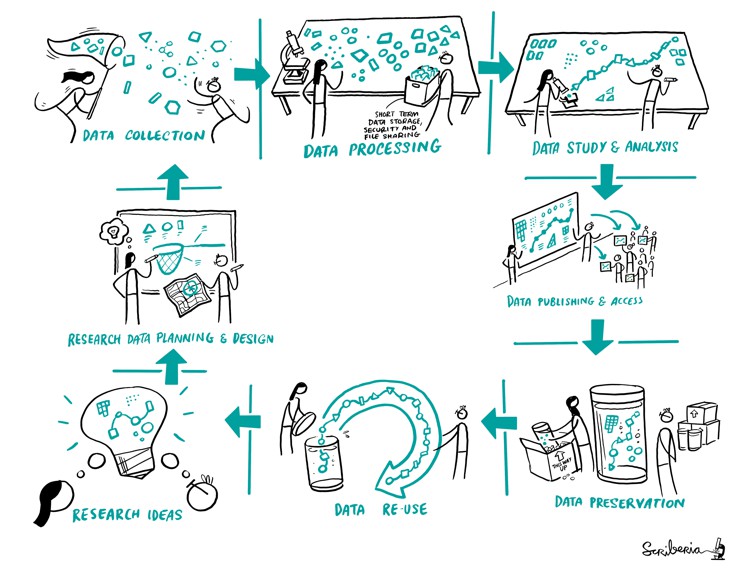Setting up a computational project
Last updated on 2023-03-22 | Edit this page
Setting up a Project
Overview
Questions
- How to set up a computational project?
- What main concerns and challenges exist and how to address them?
- How to create a project repository for sharing, collaboration and an intention to release?
Objectives
- Describe best practices for setting a project repository
- Build a basis for collaboration and co-creation in team projects
- Plan computational reproducibility and project management practices
- Make it easy for each contributor to participate, contribute and be recognised for their work

Research Lifecycle. The Turing Way project illustration by Scriberia for The Turing Way Community Shared under CC-BY 4.0 License. Zenodo. http://doi.org/10.5281/zenodo.3332807
A research project starts right with a research idea. We start by communicating that with other researchs in our team. Then come the following steps:
- planning and designing the research work
- describing the research protocols
- deciding how data will be collected
- selecting methods and practices for processing and wrangling data
- conducting our studies and analysis
- publishing all the research objects so everybody can access it
- archiving it to ensure that our research is reusable, meaning, that someone else can go through this whole process of reproducing or building upon our work.
Each of these steps is important for every single researcher, irrespective of their roles in the project. However, a project lead (such as Principal Investigators, managers and supervisors) have an added responsibility to set up the project in a way that ensures that all members of their research team can work together efficiently at all stages of the project.
With an overarching goal to maintain research integrity and ethical practices from the start, we need to consider reproducibility methods, collaborative approaches and transparent communication processes for the research team as well as the external stakeholders. As project leads, managers and team organisers, it is crucial to be deliberate and clear about the tools and platforms selected for the project, as well as expectations from each contributor from the beginning. Dedicating some time in thinking through and documenting the setup of a project saves time, ensuring successful implementation of research plans at different stages of research. At this stage, you can’t be sure that everything will always go as planned or there will be no unexpected challenges, but it helps prepare in advance for risk management and adapt to changes when needed.
Main Concerns and Challenges
Scientific results and evidence are strengthened if those results can be replicated and confirmed by several independent researchers. This means understanding and documenting the research process, describing what steps are involved, what decisions are made from design to analysis to implementation stages and publishing them for others to validate. Research projects already start with multiple documents such as project proposal, institutional policies and recommendations (including project timeline, data management plan, open access policy, grant requirements and ethical committee recommendations), which should be available to the entire research team at all times. Furthermore, throughout the lifecycle of a project we handle experimental materials such as data and code, refer to different published studies, establish collaboration with others, generate research outputs including figures, graphs and publications, many of which undergo multiple versions. Then there is a general need to document the team’s way of working, different roles and contribution types, project workflows, research process, learning resources and templates (such as for presentation, documentation, project reporting and manuscript) for your research team.
If not planned in advance, these different kinds of information related to the project can become challenging to record, manage or retrieve – costing precious time of everyone involved and negatively affecting collaborative work in your research team.
Conclusion
In addition to ensuring effective development and collaboration during the lifetime of the project, a well-organised project also ensures sustainability and reusability of research for both the developers and future users more dynamically. This aspect is discussed in detail in the Research Data Management episode.
Resources and References for Technical Details
- The Turing Way. The Turing Way Community. (2021). The Turing Way: A handbook for reproducible, ethical and collaborative research (1.0.1). Zenodo. DOI: 10.5281/zenodo.5671094
- The Good Research Code Handbook by Patrick Mineault.
- Open Life Science training and Mentoring Programme. Batut, Bérénice, Yehudi, Yo, Sharan, Malvika, Tsang, Emmy, & Open Life Science Community. (2021). Open Life Science - Training and Mentoring programme - Website release 2019-2021 (1.0.0). Zenodo. DOI: 10.5281/zenodo.5636584
Challenge
- Create a project on GitHub
- Create a Github account at https://github.com
- Go to https://github.com/tonic-team/Tonic-Research-Project-Template/
- Click
Use this templateand follow instructions.
NB: You can use that template on other git platforms.
Change the
reamde.mdfile directly on the browser: enter information about the project, commit with a message. Enter information about the team (roles and responsabilities), commit with a second message.Look at the history of the readme.md file, understand the need for good commit messages.
Keypoints
- Shared repository with well structured and organised files are crucial for starting a project
- Documentation is as important as data and code to understand the different aspects of the project and communicate about the research.
- Licencing and open science practices allow proper use and reuse of all research objects, hence should be applied in computational research from the start.
